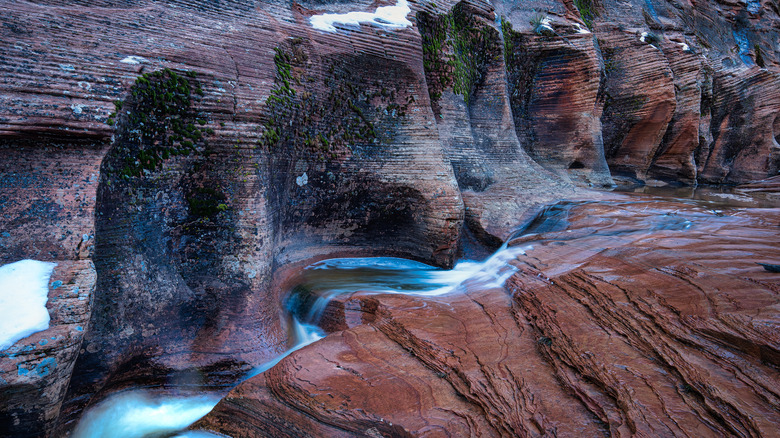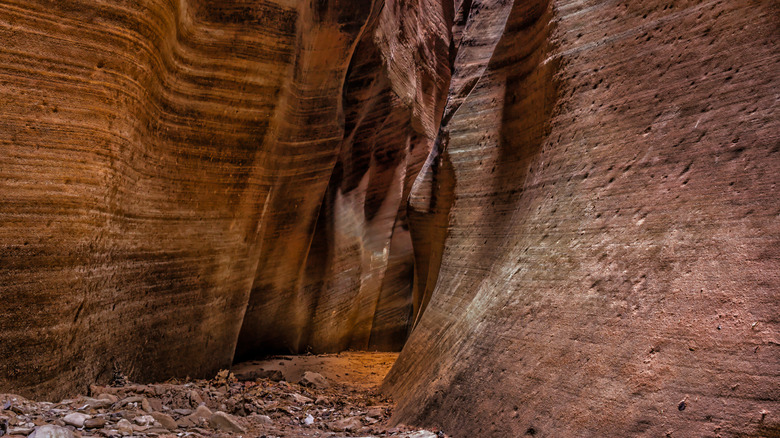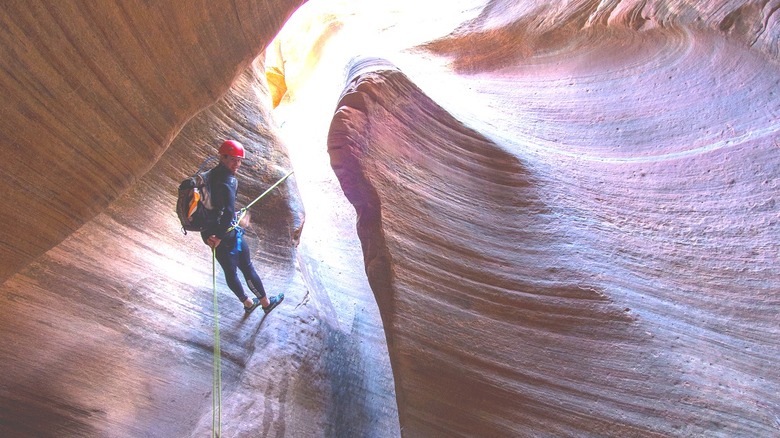The Terrifying Reason This Unsuspecting National Park Hike In Utah Is So Dangerous
Among the many reasons to visit Zion National Park, one is its magnificent and varied canyons, which attract nature lovers from all corners of the globe. Its wide, tree-lined canyons with well-maintained paths are perfect for casual walkers and families with small children, while its narrow and steep slot canyons draw scores of adventure-hungry canyoneers each year. Among the dozens of Zion's technical canyons (i.e., some rappelling and climbing are required), Keyhole Canyon doesn't jump out as one of the most challenging. One of the shortest technical canyons in the park, it can be completed in as little as 1–2 hours. Moreover, its 30-foot rappels are short compared to the spine-tingling hundred-foot drops in many of the other canyons. Keyhole must be easy peasy then, right?
Think again. If statistics are any indication, Keyhole may actually be the most dangerous canyon in Zion National Park due to the risk of deadly flash flooding. In September 2015, a thunderstorm produced a violent flash flood, which swept through the narrow chasm with terrifying results. Trapped in the canyon's deepest section, seven unsuspecting canyoneers met their deaths in the swirling waters. As reported in Outside, "The most innocuous slot in Zion had produced the worst canyoneering disaster in American history and the worst accident of any kind in Zion's 97 years."
Unpacking the Keyhole Seven accident
The seven canyoneers who died in Keyhole Canyon that day — who became known as the Keyhole Seven — were tried-and-true hikers but less experienced canyoneers, drawing a sharp distinction between the two sports. Just because you're fit, can scramble nimbly over rocks, and tend not to get lost on a hike because you're good at reading maps doesn't mean you're ready for Keyhole Canyon. Technical skills are required for the rappels, and adventurers should be prepared to get wet, as the water can be waist-high or higher in certain sections. In addition, safely traversing Keyhole and any other slot canyon requires a thorough understanding of the risks and above all, an exquisite attunement to weather patterns.
The canyoneering skills of the Keyhole Seven ranged from beginner to intermediate. All but one member of the group had taken a half-day introductory canyoneering course through the Zion Adventure Company prior to entering the canyon, suggesting that the group may not have been knowledgeable enough to adequately assess the weather risks given the dangerous topography of this specific canyon. The morning of the accident, forecasters in Salt Lake City were predicting a 40% chance of rain with a chance of heavy thunderstorms later in the day. Regardless, in the mid-afternoon, the group elected to enter Keyhole. They were deep in the canyon — where escape was impossible — when the storm unleashed its sudden and unexpected fury.
How to stay safe when canyoneering
The tragic accident involving the Keyhole Seven underscores that canyoneering, while thrilling and rewarding, can also be extremely risky. To minimize the risks, canyoneers should make an effort to develop the right skills and take all the necessary precautions. Taking a canyoneering course to learn about the basics of rope-handling and rappelling is an excellent idea, along with going with a trained guide the first handful of times until your skills are solid. To minimize risks from injury and hypothermia, wear protective clothing like a helmet (always!) and a wet suit (if it's a wet canyon). Finally, check the weather in the days before and repeatedly on the day of the adventure, with the recognition that forecasts can change suddenly in the desert. If there is more than the slightest chance of rain, please don't enter Keyhole or any other slot canyon!
Heed the risks, but don't be deterred from exploring the magical world of slot canyons. In an email to the LA Times, author and environmental activist Terry Tempest Williams described canyoneering as "a descent into the inner world ... It offers us a walk through time where canyon walls rise upward like praying hands. The desert is both beauty and terror, never to be underestimated, always to be respected. We live by wild mercy." For an example of a less dangerous canyon experience, check out this article on another amazing slot canyon in the desert southwest.


